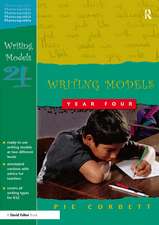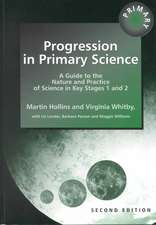Where's the Wonder in Elementary Math?: Encouraging Mathematical Reasoning in the Classroom: Transforming Teaching
Autor Judith McVarishen Limba Engleză Paperback – 24 aug 2007
| Toate formatele și edițiile | Preț | Express |
|---|---|---|
| Paperback (1) | 372.16 lei 6-8 săpt. | |
| Taylor & Francis – 24 aug 2007 | 372.16 lei 6-8 săpt. | |
| Hardback (1) | 1275.23 lei 6-8 săpt. | |
| Taylor & Francis – 27 aug 2007 | 1275.23 lei 6-8 săpt. |
Din seria Transforming Teaching
-
 Preț: 399.03 lei
Preț: 399.03 lei -
 Preț: 398.82 lei
Preț: 398.82 lei -
 Preț: 418.74 lei
Preț: 418.74 lei -
 Preț: 445.78 lei
Preț: 445.78 lei -
 Preț: 401.70 lei
Preț: 401.70 lei -
 Preț: 324.88 lei
Preț: 324.88 lei - 18%
 Preț: 1012.69 lei
Preț: 1012.69 lei -
 Preț: 453.97 lei
Preț: 453.97 lei
Preț: 372.16 lei
Nou
Puncte Express: 558
Preț estimativ în valută:
71.22€ • 74.69$ • 59.28£
71.22€ • 74.69$ • 59.28£
Carte tipărită la comandă
Livrare economică 01-15 aprilie
Preluare comenzi: 021 569.72.76
Specificații
ISBN-13: 9780415957168
ISBN-10: 0415957168
Pagini: 196
Ilustrații: 20 b/w images
Dimensiuni: 178 x 254 x 11 mm
Greutate: 0.36 kg
Ediția:1
Editura: Taylor & Francis
Colecția Routledge
Seria Transforming Teaching
Locul publicării:Oxford, United Kingdom
ISBN-10: 0415957168
Pagini: 196
Ilustrații: 20 b/w images
Dimensiuni: 178 x 254 x 11 mm
Greutate: 0.36 kg
Ediția:1
Editura: Taylor & Francis
Colecția Routledge
Seria Transforming Teaching
Locul publicării:Oxford, United Kingdom
Cuprins
Introduction 1. Setting the Stage 2. What Does the Room Teach? 3. Who Asks the Questions – Who Answers Them? 4. Tuning Transitions to a New Key 5. What is Real About Homework? 6. De-Fanging the Test 7. How Can We Take Critical Thinking Beyond the Classroom? 8. What do Parents Know? 9. Is Thinking About Thinking Just a Play on Words?
Recenzii
Kay A. Wohlhuter, Professor, Department of Education, University of Minnesota
I recommend this book for publication. The first reason is because of the content of the book. The author is providing relevant information that provides knowledge, should generate conversation between stakeholders, and should prompt action in response to the conversations about developing mathematical reasoners in elementary classrooms while meeting the demands of curriculums and mandated tests. Accountability is important, but it should not occur at the expense of developing mathematical problem solvers. There needs to be a way to do both, and I think this book addresses that challenge. A related reason involves the fact that the author does take into consideration all of the stakeholders. Teachers, administrators, parents, school board members, and legislators could all learn from this book. Although elementary children will not be reading this book, their role in the elementary mathematics classroom is central to the book’s discussion. Additional support for my recommendation is because of the author’s use of questions generated from her teaching and professional work to frame the discussion. This structure enables the readers to see that the information presented in the book is reality-based. The use of teacher action research studies also lends credibility to the classroom reality-based information.
Linda Dacey, Professor, Department of Education, Lessly University
I think the author is addressing a powerful concern in a creative manner. The idea that the teacher still has freedom in "peripheral spaces" is interesting and allows one to view the "problem" of test-only focus from a new perspective. . . The table of contents is strong. Teachers will be interested in the many practical suggestions that I would expect to be included under these headings.
Thomas Biggs, Elementary Math Specialist for grades K – 5
The strengths of this book are simple and straightforward. A book which is practical, useful, contemporary, and relevant to the market of preservice teachers and mathematics methods course students (both undergraduate and graduate levels).I am unaware of any other textbook which directly addresses or refers to the topics which are brought up in this text. This book is a publishable and useful text.
I recommend this book for publication. The first reason is because of the content of the book. The author is providing relevant information that provides knowledge, should generate conversation between stakeholders, and should prompt action in response to the conversations about developing mathematical reasoners in elementary classrooms while meeting the demands of curriculums and mandated tests. Accountability is important, but it should not occur at the expense of developing mathematical problem solvers. There needs to be a way to do both, and I think this book addresses that challenge. A related reason involves the fact that the author does take into consideration all of the stakeholders. Teachers, administrators, parents, school board members, and legislators could all learn from this book. Although elementary children will not be reading this book, their role in the elementary mathematics classroom is central to the book’s discussion. Additional support for my recommendation is because of the author’s use of questions generated from her teaching and professional work to frame the discussion. This structure enables the readers to see that the information presented in the book is reality-based. The use of teacher action research studies also lends credibility to the classroom reality-based information.
Linda Dacey, Professor, Department of Education, Lessly University
I think the author is addressing a powerful concern in a creative manner. The idea that the teacher still has freedom in "peripheral spaces" is interesting and allows one to view the "problem" of test-only focus from a new perspective. . . The table of contents is strong. Teachers will be interested in the many practical suggestions that I would expect to be included under these headings.
Thomas Biggs, Elementary Math Specialist for grades K – 5
The strengths of this book are simple and straightforward. A book which is practical, useful, contemporary, and relevant to the market of preservice teachers and mathematics methods course students (both undergraduate and graduate levels).I am unaware of any other textbook which directly addresses or refers to the topics which are brought up in this text. This book is a publishable and useful text.
Descriere
This book argues that even in today's high-stakes testing environment, "teaching to the test" need not be teachers’ only focus as they introduce young children to mathematics. Judith McVarish demonstrates how building a community of learners and using problem solving to engage students can help teachers encourage students’ disposition to creative thinking and reasoning—skills that can otherwise become lost due to the pressure of the many other expectations placed upon both teachers and students. This book offers strategies for infusing mathematics learning and reasoning into elementary school classrooms while meeting curriculum and testing mandates. The teacher researcher component of each chapter provides a vehicle for teachers to bring their own expertise and questions back into the teaching and learning equation.















